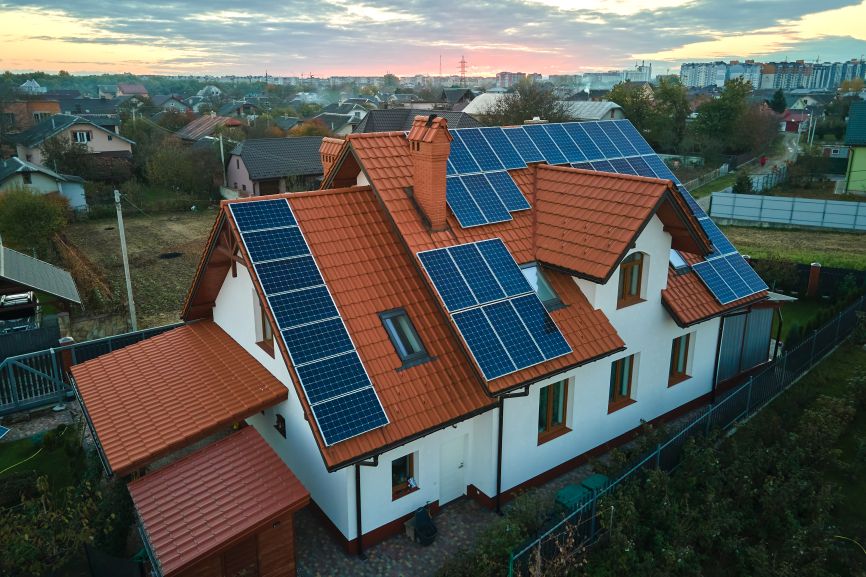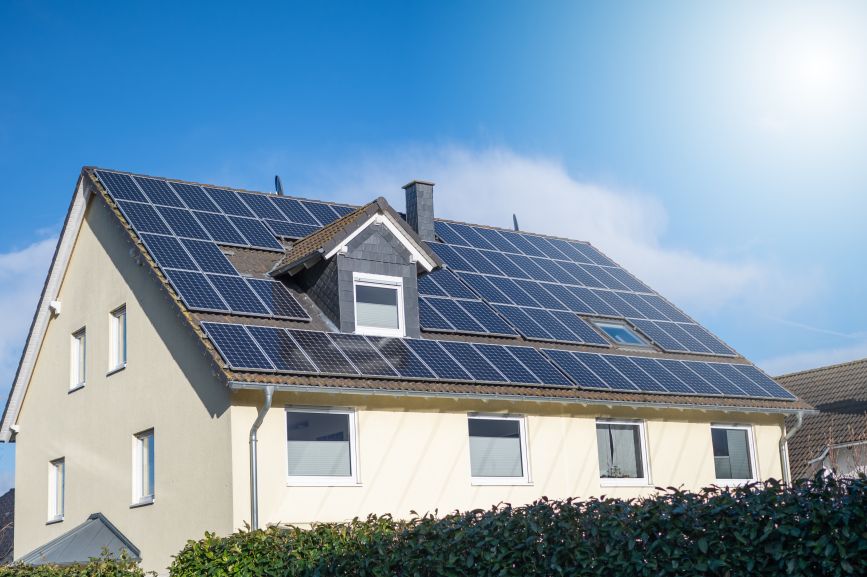If you’re a homeowner in New Jersey, Massachusetts, California, or Texas, you’ve probably wondered if solar panels can truly run your entire house. Between rising electric bills, unpredictable weather, and constant rate hikes, it’s a fair question. The short answer? Yes -solar panels can power a whole house when designed and installed correctly.
At First Solar Installers, we specialize in building complete solar energy systems tailored to your home’s energy needs and climate. From smart system design to high-efficiency panels and battery storage, we make clean energy practical, reliable, and cost-effective.

How Solar Panels Power Your Home
Think of your solar setup as a mini power plant right on your roof. Here’s how it works:
- Energy Generation – Solar panels capture sunlight and convert it into electricity (DC power).
- Conversion – An inverter transforms that DC into AC power -the same kind your home uses.
- Usage & Storage – Your home runs directly on solar power during the day. Any extra energy gets stored in a battery system or sent to the utility grid.
- Nighttime & Backup – When the sun goes down, stored energy (or grid power) keeps your home running seamlessly.
If your system includes solar batteries, you can use stored energy at night or during outages -giving you greater independence from the grid.
What You Need to Power a Whole House with Solar
To keep your entire home running on solar, you’ll need four main components working together:
1. Sufficient Solar Panels
The number of panels depends on your energy consumption, roof space, and local sunlight hours.
- A 2,000 sq. ft. home typically needs 15–20 panels to fully offset power use.
- Homes in sunnier states like Texas or California may need fewer panels compared to cloudier regions like Massachusetts or New Jersey.
2. Solar Inverter
This converts solar energy into usable electricity for your appliances and lights. High-quality inverters ensure maximum efficiency and reliability.
3. Battery Storage
A solar battery lets you store excess power for nighttime or cloudy days. It’s key if you want true energy independence or protection during grid outages.
4. Grid Connection (Optional but Smart)
Even with batteries, staying connected to the grid provides backup power and access to net metering, where you earn credits for sending excess power back to your utility.
How Many Solar Panels Does It Take?
This depends on your household energy usage, which varies based on:
- Number of residents
- Appliance types (especially HVAC systems and pool heaters)
- Lifestyle and energy habits
For example:
- A family in California using around 900 kWh/month might need a 6 kW system (15 panels).
- A larger home in New Jersey using 1,200 kWh/month may require an 8 kW system (20 panels).
A professional installer like First Solar Installers will analyze your utility bills, roof angle, and shading to design the right system size -no guesswork needed.

What About Air Conditioning and Heavy Appliances?
Yes -your AC units, washers, dryers, and ovens can all run on solar energy. The key is proper system sizing. If your summer air conditioning use spikes, your solar array can be designed to handle that extra load.
If you’re using battery storage, your system can even keep essential circuits powered during blackouts -something many homeowners in Texas and California appreciate during heat waves or grid outages.
Why Some Homeowners Still See Electric Bills
If you already have solar but still get high utility bills, there are a few common causes:
- System too small for your home’s actual usage
- Poor sun exposure or shading issues
- Increased electricity use since installation
- No battery backup, forcing grid reliance at night
First Solar Installers often helps homeowners reassess and expand existing systems to achieve full coverage and lower bills.
The Benefits of Powering Your Whole Home with Solar
- Slash or eliminate your electricity bills
- Increase home value
- Gain energy independence from rising utility costs
- Qualify for federal and state incentives (like the 30% Federal Solar Tax Credit)
- Reduce your carbon footprint
When installed by certified professionals, solar power doesn’t just save you money -it gives you control and stability in an unpredictable energy market.
Cost and ROI: Is It Worth It?
A full-home solar system is an investment, but most homeowners see a payback within 6–9 years, depending on state incentives and energy rates. After that, your power is virtually free for 20+ years.
With financing options and incentives, going solar is more accessible than ever. And when you work with First Solar Installers, our team handles everything -from design and permitting to installation and maintenance -so you can go solar with confidence.
Final Thoughts: Yes, Solar Can Power Your Entire Home
Can solar panels power a whole house? Absolutely -and thousands of homeowners are already doing it. The key is choosing the right system, components, and installer.
If you’re ready to explore full-home solar in New Jersey, Massachusetts, California, or Texas, First Solar Installers can design a system built around your energy goals, budget, and lifestyle.
Call us today to get a free quote!
Get your free solar estimate today at First Solar Installers and start powering your home the smart way.